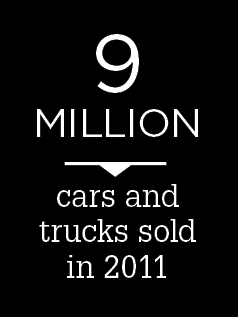Although Michael J. Weidman grew up in upstate New York, his first job pulled him 400 miles west to Detroit. He’s been hooked on the automotive industry ever since. To find out what keeps him married to the Motor City, Profile recently spoke with Weidman about his 23-year career at General Motors, where he spent seven years in the marketing department at Saturn before transitioning in 1996 to Chevrolet, and his current role as marketing manager for the Chevrolet Cruze.
As a kid I was an automotive enthusiast. I had a subscription to Hot Rod magazine. And then, to be quite honest, my interest waned for a little while. But, once you end up moving to Detroit you can’t help but get immersed in the automotive culture. It’s a part of our everyday life around here. Everything we do, see, feel, and touch involves in one way, shape, or form the automotive industry.
 While I was at Saturn, I took a job in the field. Every marketing person in the automotive industry needs to spend time in the field because that’s where the rubber meets the road. You need to fully understand and comprehend how dealers think. You need to know what the conversation is like not only on the salesroom floor, but also on the service floor. Until you have a great feel for that piece of the business, you’ll never truly be a good marketer. What I learned is: The person who’s out on the showroom floor has to sell the entire gamut of Chevrolet brands. And they need to know how our brands compare to competitors’ brands. It’s overwhelming. As a marketer, therefore, I don’t want to overload them with facts and figures when I’m telling them how to sell a vehicle. Instead, I need to give them only the three or four most pertinent things that are going to make them more effective on the showroom floor.
While I was at Saturn, I took a job in the field. Every marketing person in the automotive industry needs to spend time in the field because that’s where the rubber meets the road. You need to fully understand and comprehend how dealers think. You need to know what the conversation is like not only on the salesroom floor, but also on the service floor. Until you have a great feel for that piece of the business, you’ll never truly be a good marketer. What I learned is: The person who’s out on the showroom floor has to sell the entire gamut of Chevrolet brands. And they need to know how our brands compare to competitors’ brands. It’s overwhelming. As a marketer, therefore, I don’t want to overload them with facts and figures when I’m telling them how to sell a vehicle. Instead, I need to give them only the three or four most pertinent things that are going to make them more effective on the showroom floor.
When you’re marketing a vehicle, the most important thing is the fundamentals. The glitziest ad in the world won’t matter if you don’t get the fundamentals right. What I mean by that is: Do you have the right content on the vehicle at the right trim levels? Do you have the vehicle priced properly versus the competition? Is the sales associate properly trained to sell the vehicle? Once you’ve mastered the fundamentals, you can transition to the fun side of a launch, which is the advertising and promotions side.
When we initially went to launch Cruze, I think we tried to do a little too much. When they think about compact cars, people initially think about young buyers, but that’s only about a quarter of the market. The bulk of the buyers in the compact-car segment are 45 to 65 years old. In our launch ads we tried to reach both ends of the buyer base, which may have been a mistake. In December 2010 we reevaluated and decided to focus on the older millennial buyer. We started doing a lot more in the digital and social spaces. Fortunately, we hit the perfect storm, to the point where last June [2011] Cruze was the number-one selling automobile in the United States.
What’s made me effective is striving to maintain a work/life balance. When we’re researching consumers, we travel around the country and go into individuals’ homes. I’ll sit down and talk to them for two or three hours to find out what makes them tick. When we were doing research for the Malibu, we asked a customer about what’s important in a vehicle. They said it has to be quiet inside. I thought, “A quiet vehicle translates into perceived high quality.” But that wasn’t why it was important. It was important because people no longer have traditional family dinners. The only chance they have to communicate with their kids is when they’re in the vehicle with them, transporting them to and from all their various sporting events and activities. The more you understand what consumers are going through, the better the marketer you’ll be.















